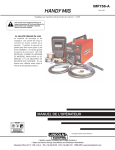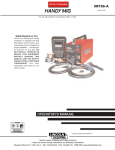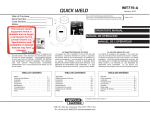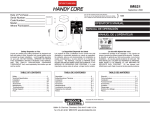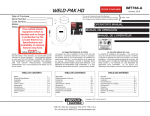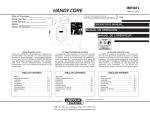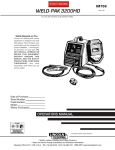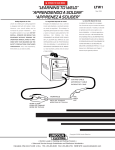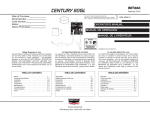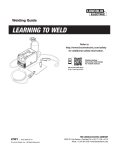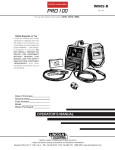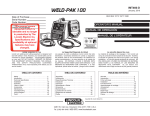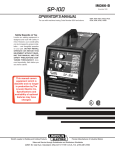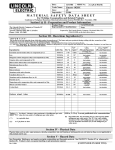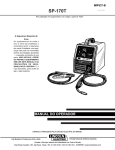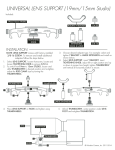Download Lincoln Electric IM822 User's Manual
Transcript
RETURN TO MAIN MENU IM822 MIG PAK HD February, 2003 For use with machine Code Number:11062 Safety Depends on You Lincoln arc welding and cutting equipment is designed and built with safety in mind. However, your overall safety can be increased by proper installation ... and thoughtful operation on your part. DO NOT INSTALL, OPERATE OR REPAIR THIS EQUIPMENT WITHOUT READING THIS MANUAL AND THE SAFETY PRECAUTIONS CONTAINED THROUGHOUT. And, most importantly, think before you act and be careful. Date of Purchase: Serial Number: Code Number: Model: Where Purchased: OPERATOR’S MANUAL Copyright © 2003 Lincoln Global Inc. • World's Leader in Welding and Cutting Products • • Sales and Service through Subsidiaries and Distributors Worldwide • Cleveland, Ohio 44117-1199 U.S.A. TEL: 216.481.8100 FAX: 216.486.1751 WEB SITE: www.lincolnelectric.com i i SAFETY WARNING CALIFORNIA PROPOSITION 65 WARNINGS The engine exhaust from this product contains Diesel engine exhaust and some of its constituents chemicals known to the State of California to cause are known to the State of California to cause cancancer, birth defects, or other reproductive harm. cer, birth defects, and other reproductive harm. The Above For Gasoline Engines The Above For Diesel Engines ARC WELDING CAN BE HAZARDOUS. PROTECT YOURSELF AND OTHERS FROM POSSIBLE SERIOUS INJURY OR DEATH. KEEP CHILDREN AWAY. PACEMAKER WEARERS SHOULD CONSULT WITH THEIR DOCTOR BEFORE OPERATING. Read and understand the following safety highlights. For additional safety information, it is strongly recommended that you purchase a copy of “Safety in Welding & Cutting - ANSI Standard Z49.1” from the American Welding Society, P.O. Box 351040, Miami, Florida 33135 or CSA Standard W117.2-1974. A Free copy of “Arc Welding Safety” booklet E205 is available from the Lincoln Electric Company, 22801 St. Clair Avenue, Cleveland, Ohio 44117-1199. BE SURE THAT ALL INSTALLATION, OPERATION, MAINTENANCE AND REPAIR PROCEDURES ARE PERFORMED ONLY BY QUALIFIED INDIVIDUALS. FOR ENGINE powered equipment. 1.h. To avoid scalding, do not remove the radiator pressure cap when the engine is hot. 1.a. Turn the engine off before troubleshooting and maintenance work unless the maintenance work requires it to be running. ____________________________________________________ 1.b.Operate engines in open, well-ventilated areas or vent the engine exhaust fumes outdoors. ____________________________________________________ 1.c. Do not add the fuel near an open flame welding arc or when the engine is running. Stop the engine and allow it to cool before refueling to prevent spilled fuel from vaporizing on contact with hot engine parts and igniting. Do not spill fuel when filling tank. If fuel is spilled, wipe it up and do not start engine until fumes have been eliminated. ____________________________________________________ 1.d. Keep all equipment safety guards, covers and devices in position and in good repair.Keep hands, hair, clothing and tools away from V-belts, gears, fans and all other moving parts when starting, operating or repairing equipment. ____________________________________________________ 1.e. In some cases it may be necessary to remove safety guards to perform required maintenance. Remove guards only when necessary and replace them when the maintenance requiring their removal is complete. Always use the greatest care when working near moving parts. ___________________________________________________ 1.f. Do not put your hands near the engine fan. Do not attempt to override the governor or idler by pushing on the throttle control rods while the engine is running. ELECTRIC AND MAGNETIC FIELDS may be dangerous 2.a. Electric current flowing through any conductor causes localized Electric and Magnetic Fields (EMF). Welding current creates EMF fields around welding cables and welding machines 2.b. EMF fields may interfere with some pacemakers, and welders having a pacemaker should consult their physician before welding. 2.c. Exposure to EMF fields in welding may have other health effects which are now not known. 2.d. All welders should use the following procedures in order to minimize exposure to EMF fields from the welding circuit: 2.d.1. Route the electrode and work cables together - Secure them with tape when possible. 2.d.2. Never coil the electrode lead around your body. 2.d.3. Do not place your body between the electrode and work cables. If the electrode cable is on your right side, the work cable should also be on your right side. 2.d.4. Connect the work cable to the workpiece as close as possible to the area being welded. ___________________________________________________ 1.g. To prevent accidentally starting gasoline engines while turning the engine or welding generator during maintenance work, disconnect the spark plug wires, distributor cap or magneto wire as appropriate. 2.d.5. Do not work next to welding power source. Mar ‘95 ii ii SAFETY ARC RAYS can burn. ELECTRIC SHOCK can kill. 3.a. The electrode and work (or ground) circuits are electrically “hot” when the welder is on. Do not touch these “hot” parts with your bare skin or wet clothing. Wear dry, hole-free gloves to insulate hands. 3.b. Insulate yourself from work and ground using dry insulation. Make certain the insulation is large enough to cover your full area of physical contact with work and ground. In addition to the normal safety precautions, if welding must be performed under electrically hazardous conditions (in damp locations or while wearing wet clothing; on metal structures such as floors, gratings or scaffolds; when in cramped positions such as sitting, kneeling or lying, if there is a high risk of unavoidable or accidental contact with the workpiece or ground) use the following equipment: • Semiautomatic DC Constant Voltage (Wire) Welder. • DC Manual (Stick) Welder. • AC Welder with Reduced Voltage Control. 3.c. In semiautomatic or automatic wire welding, the electrode, electrode reel, welding head, nozzle or semiautomatic welding gun are also electrically “hot”. 3.d. Always be sure the work cable makes a good electrical connection with the metal being welded. The connection should be as close as possible to the area being welded. 3.e. Ground the work or metal to be welded to a good electrical (earth) ground. 3.f. Maintain the electrode holder, work clamp, welding cable and welding machine in good, safe operating condition. Replace damaged insulation. 3.g. Never dip the electrode in water for cooling. 3.h. Never simultaneously touch electrically “hot” parts of electrode holders connected to two welders because voltage between the two can be the total of the open circuit voltage of both welders. 3.i. When working above floor level, use a safety belt to protect yourself from a fall should you get a shock. 3.j. Also see Items 6.c. and 8. 4.a. Use a shield with the proper filter and cover plates to protect your eyes from sparks and the rays of the arc when welding or observing open arc welding. Headshield and filter lens should conform to ANSI Z87. I standards. 4.b. Use suitable clothing made from durable flame-resistant material to protect your skin and that of your helpers from the arc rays. 4.c. Protect other nearby personnel with suitable, non-flammable screening and/or warn them not to watch the arc nor expose themselves to the arc rays or to hot spatter or metal. FUMES AND GASES can be dangerous. 5.a. Welding may produce fumes and gases hazardous to health. Avoid breathing these fumes and gases.When welding, keep your head out of the fume. Use enough ventilation and/or exhaust at the arc to keep fumes and gases away from the breathing zone. When welding with electrodes which require special ventilation such as stainless or hard facing (see instructions on container or MSDS) or on lead or cadmium plated steel and other metals or coatings which produce highly toxic fumes, keep exposure as low as possible and below Threshold Limit Values (TLV) using local exhaust or mechanical ventilation. In confined spaces or in some circumstances, outdoors, a respirator may be required. Additional precautions are also required when welding on galvanized steel. 5.b. Do not weld in locations near chlorinated hydrocarbon vapors coming from degreasing, cleaning or spraying operations. The heat and rays of the arc can react with solvent vapors to form phosgene, a highly toxic gas, and other irritating products. 5.c. Shielding gases used for arc welding can displace air and cause injury or death. Always use enough ventilation, especially in confined areas, to insure breathing air is safe. 5.d. Read and understand the manufacturer’s instructions for this equipment and the consumables to be used, including the material safety data sheet (MSDS) and follow your employer’s safety practices. MSDS forms are available from your welding distributor or from the manufacturer. 5.e. Also see item 1.b. Mar ‘95 iii iii SAFETY WELDING SPARKS can cause fire or explosion. 6.a. Remove fire hazards from the welding area. If this is not possible, cover them to prevent the welding sparks from starting a fire. Remember that welding sparks and hot materials from welding can easily go through small cracks and openings to adjacent areas. Avoid welding near hydraulic lines. Have a fire extinguisher readily available. 6.b. Where compressed gases are to be used at the job site, special precautions should be used to prevent hazardous situations. Refer to “Safety in Welding and Cutting” (ANSI Standard Z49.1) and the operating information for the equipment being used. 6.c. When not welding, make certain no part of the electrode circuit is touching the work or ground. Accidental contact can cause overheating and create a fire hazard. 6.d. Do not heat, cut or weld tanks, drums or containers until the proper steps have been taken to insure that such procedures will not cause flammable or toxic vapors from substances inside. They can cause an explosion even though they have been “cleaned”. For information, purchase “Recommended Safe Practices for the Preparation for Welding and Cutting of Containers and Piping That Have Held Hazardous Substances”, AWS F4.1 from the American Welding Society (see address above). 6.e. Vent hollow castings or containers before heating, cutting or welding. They may explode. 6.f. Sparks and spatter are thrown from the welding arc. Wear oil free protective garments such as leather gloves, heavy shirt, cuffless trousers, high shoes and a cap over your hair. Wear ear plugs when welding out of position or in confined places. Always wear safety glasses with side shields when in a welding area. 6.g. Connect the work cable to the work as close to the welding area as practical. Work cables connected to the building framework or other locations away from the welding area increase the possibility of the welding current passing through lifting chains, crane cables or other alternate circuits. This can create fire hazards or overheat lifting chains or cables until they fail. 6.h. Also see item 1.c. CYLINDER may explode if damaged. 7.a. Use only compressed gas cylinders containing the correct shielding gas for the process used and properly operating regulators designed for the gas and pressure used. All hoses, fittings, etc. should be suitable for the application and maintained in good condition. 7.b. Always keep cylinders in an upright position securely chained to an undercarriage or fixed support. 7.c. Cylinders should be located: • Away from areas where they may be struck or subjected to physical damage. • A safe distance from arc welding or cutting operations and any other source of heat, sparks, or flame. 7.d. Never allow the electrode, electrode holder or any other electrically “hot” parts to touch a cylinder. 7.e. Keep your head and face away from the cylinder valve outlet when opening the cylinder valve. 7.f. Valve protection caps should always be in place and hand tight except when the cylinder is in use or connected for use. 7.g. Read and follow the instructions on compressed gas cylinders, associated equipment, and CGA publication P-l, “Precautions for Safe Handling of Compressed Gases in Cylinders,” available from the Compressed Gas Association 1235 Jefferson Davis Highway, Arlington, VA 22202. FOR ELECTRICALLY powered equipment. 8.a. Turn off input power using the disconnect switch at the fuse box before working on the equipment. 8.b. Install equipment in accordance with the U.S. National Electrical Code, all local codes and the manufacturer’s recommendations. 8.c. Ground the equipment in accordance with the U.S. National Electrical Code and the manufacturer’s recommendations. Mar ‘95 iv iv SAFETY PRÉCAUTIONS DE SÛRETÉ Pour votre propre protection lire et observer toutes les instructions et les précautions de sûreté specifiques qui parraissent dans ce manuel aussi bien que les précautions de sûreté générales suivantes: Sûreté Pour Soudage A L’Arc 1. Protegez-vous contre la secousse électrique: a. Les circuits à l’électrode et à la piéce sont sous tension quand la machine à souder est en marche. Eviter toujours tout contact entre les parties sous tension et la peau nue ou les vétements mouillés. Porter des gants secs et sans trous pour isoler les mains. b. Faire trés attention de bien s’isoler de la masse quand on soude dans des endroits humides, ou sur un plancher metallique ou des grilles metalliques, principalement dans les positions assis ou couché pour lesquelles une grande partie du corps peut être en contact avec la masse. c. Maintenir le porte-électrode, la pince de masse, le câble de soudage et la machine à souder en bon et sûr état defonctionnement. d.Ne jamais plonger le porte-électrode dans l’eau pour le refroidir. e. Ne jamais toucher simultanément les parties sous tension des porte-électrodes connectés à deux machines à souder parce que la tension entre les deux pinces peut être le total de la tension à vide des deux machines. f. Si on utilise la machine à souder comme une source de courant pour soudage semi-automatique, ces precautions pour le porte-électrode s’applicuent aussi au pistolet de soudage. 2. Dans le cas de travail au dessus du niveau du sol, se protéger contre les chutes dans le cas ou on recoit un choc. Ne jamais enrouler le câble-électrode autour de n’importe quelle partie du corps. 3. Un coup d’arc peut être plus sévère qu’un coup de soliel, donc: a. Utiliser un bon masque avec un verre filtrant approprié ainsi qu’un verre blanc afin de se protéger les yeux du rayonnement de l’arc et des projections quand on soude ou quand on regarde l’arc. b. Porter des vêtements convenables afin de protéger la peau de soudeur et des aides contre le rayonnement de l‘arc. c. Protéger l’autre personnel travaillant à proximité au soudage à l’aide d’écrans appropriés et non-inflammables. 4. Des gouttes de laitier en fusion sont émises de l’arc de soudage. Se protéger avec des vêtements de protection libres de l’huile, tels que les gants en cuir, chemise épaisse, pantalons sans revers, et chaussures montantes. 5. Toujours porter des lunettes de sécurité dans la zone de soudage. Utiliser des lunettes avec écrans lateraux dans les zones où l’on pique le laitier. 6. Eloigner les matériaux inflammables ou les recouvrir afin de prévenir tout risque d’incendie dû aux étincelles. 7. Quand on ne soude pas, poser la pince à une endroit isolé de la masse. Un court-circuit accidental peut provoquer un échauffement et un risque d’incendie. 8. S’assurer que la masse est connectée le plus prés possible de la zone de travail qu’il est pratique de le faire. Si on place la masse sur la charpente de la construction ou d’autres endroits éloignés de la zone de travail, on augmente le risque de voir passer le courant de soudage par les chaines de levage, câbles de grue, ou autres circuits. Cela peut provoquer des risques d’incendie ou d’echauffement des chaines et des câbles jusqu’à ce qu’ils se rompent. 9. Assurer une ventilation suffisante dans la zone de soudage. Ceci est particuliérement important pour le soudage de tôles galvanisées plombées, ou cadmiées ou tout autre métal qui produit des fumeés toxiques. 10. Ne pas souder en présence de vapeurs de chlore provenant d’opérations de dégraissage, nettoyage ou pistolage. La chaleur ou les rayons de l’arc peuvent réagir avec les vapeurs du solvant pour produire du phosgéne (gas fortement toxique) ou autres produits irritants. 11. Pour obtenir de plus amples renseignements sur la sûreté, voir le code “Code for safety in welding and cutting” CSA Standard W 117.2-1974. PRÉCAUTIONS DE SÛRETÉ POUR LES MACHINES À SOUDER À TRANSFORMATEUR ET À REDRESSEUR 1. Relier à la terre le chassis du poste conformement au code de l’électricité et aux recommendations du fabricant. Le dispositif de montage ou la piece à souder doit être branché à une bonne mise à la terre. 2. Autant que possible, I’installation et l’entretien du poste seront effectués par un électricien qualifié. 3. Avant de faires des travaux à l’interieur de poste, la debrancher à l’interrupteur à la boite de fusibles. 4. Garder tous les couvercles et dispositifs de sûreté à leur place. Mar. ‘93 v v Thank You for selecting a QUALITY product by Lincoln Electric. We want you to take pride in operating this Lincoln Electric Company product ••• as much pride as we have in bringing this product to you! Please Examine Carton and Equipment For Damage Immediately When this equipment is shipped, title passes to the purchaser upon receipt by the carrier. Consequently, Claims for material damaged in shipment must be made by the purchaser against the transportation company at the time the shipment is received. Please record your equipment identification information below for future reference. This information can be found on your machine nameplate. Model Name & Number _____________________________________ Code & Serial Number _____________________________________ Date of Purchase _____________________________________ Whenever you request replacement parts for product registration on-line or information on this equipment always supply the information you have recorded above. Read this Operators Manual completely before attempting to use this equipment. Save this manual and keep it handy for quick reference. Pay particular attention to the safety instructions we have provided for your protection. The level of seriousness to be applied to each is explained below: WARNING This statement appears where the information must be followed exactly to avoid serious personal injury or loss of life. CAUTION This statement appears where the information must be followed to avoid minor personal injury or damage to this equipment. vi MASTER TABLE OF CONTENTS FOR ALL SECTIONS Page Installation .......................................................................................................Section A Technical Specifications ........................................................................................A-1 Identify and Locate Components ...........................................................................A-2 Select Suitable Location ........................................................................................A-3 Stacking .................................................................................................................A-3 Changing Polarity ..................................................................................................A-3 Gun Installation......................................................................................................A-3 Input Connections..................................................................................................A-3 Gas Connections ...................................................................................................A-3 Shielding Gas Connections ...................................................................................A-4 Code Requirements ..............................................................................................A-4 ________________________________________________________________________ Operation .........................................................................................................Section B Safety Precautions ................................................................................................B-1 General Description ...............................................................................................B-1 Recommended Processes.....................................................................................B-1 Operation Features and Controls .........................................................................B-1 Design Features ....................................................................................................B-1 Welding Capability .................................................................................................B-2 Limitations..............................................................................................................B-2 Controls and Settings ............................................................................................B-2 Welding Operations ...............................................................................................B-2 Shielding Gas ........................................................................................................B-3 Making a Weld and Process Table ........................................................................B-4 Cleaning Tip and Gas Nozzle ................................................................................B-5 Changing Machine over to Feed Other Wire Sizes,Overload Protection...............B-5 Learning to Weld....................................................................................B-6 thru B-16 ________________________________________________________________________ Accessories .....................................................................................................Section C Accessories ...........................................................................................................C-1 Replacement Parts ................................................................................................C-1 ________________________________________________________________________ Maintenance ....................................................................................................Section D Safety Precautions ................................................................................................D-1 Items Requiring No Maintenance ..........................................................................D-1 Routine Maintenance.............................................................................................D-1 Cleaning the Gun Liner..........................................................................................D-2 Cleaning Components as Required.......................................................................D-2 Component Replacement Procedures ..................................................................D-2 Changing Contact Tip............................................................................................D-2 Changing the Drive Roll.........................................................................................D-2 Gun Assembly Removal ........................................................................................D-3 Work Cable Installation..........................................................................................D-3 ________________________________________________________________________ Troubleshooting ..............................................................................................Section E Safety Precautions.................................................................................................E-1 How to Use Troubleshooting Guide.......................................................................E-1 Troubleshooting Guide.........................................................................E-2 THRU E-4 ________________________________________________________________________ Wiring Diagrams ..............................................................................................Section F Wiring Diagram .....................................................................................................F-1 ________________________________________________________________________ Parts Lists ....................................................................................................P437 Series A-1 A-1 INSTALLATION TECHNICAL SPECIFICATIONS – MIG PAK HD INPUT – SINGLE PHASE ONLY Standard Voltage/Frequency 120V/60Hz Input Current 20 Amps @ Rated Output RATED OUTPUT Duty Cycle 20% Duty Cycle Amps 70 Volts at Rated Amperes 17 OUTPUT RANGE Welding Current Range DC OUTPUT: 35-88 Amps Maximum-Open Circuit Voltage 29V No Load 0 - 450 in/min (0 - 17.7 mm/min) While welding 0-300 in/min. (0-11.8 mm/min.) RECOMMENDED INPUT CABLE AND FUSE SIZES Output Mode Input Voltage Fuse or Breaker Size1 Input Amps Power Cord Extension Cord AT RATED OUTPUT 120V/60Hz 20 Amp 20 15 Amp, 125V, Three Prong Plug (NEMA Type 5-15P) Three Conductor #12 AWG (3.3 mm2) or Larger Up to 50 Ft. (15.2 mm) PHYSICAL DIMENSIONS Height 12.8 in 325 mm 1If Width 8.8 in 224 mm Depth 18 in 457 mm connected to a circuit protected by fuses use Time Delay Fuse marked “D”. MIG PAK HD Weight 46 Ibs 20.9 kg A-2 A-2 INSTALLATION Read entire installation section before starting installation. FIGURE A.1 SAFETY PRECAUTIONS 1 WARNING ELECTRIC SHOCK can kill. • Only qualified personnel should perform this installation. • Only personnel that have read and understood the Machine Operating Manual should install and operate this equipment. • Machine must be plugged into a receptacle which is grounded per any national, local or other applicable electrical codes. IM000 2 OPERATOR'S MANUAL For use with machines having Code Numbers: October 1998 00000 3 Safety Depends on You Lincoln arc welding and cutting equipment is designed and built with safety in mind. However, your overall safety can be increased by proper installation...and thoughtful operation on your part. DO NOT INSTALL, OPERATE OR REPAIR THIS EQUIPMENT WITHOUT READING THIS MANUAL AND THE SAFETT PRECAUTIONS CONTAINED THROUGHOUT. And, most importantly, think before you act and be careful. • The Machine power switch is to be in the OFF (“O”) position when installing work cable and gun and when connecting power cord to input power. World's Leader in Welding and Cutting Products Premier Manufacturer of Industrial Motors Sales and Service through Subsidiaries and Distributors Worldwide 22801 St. Clair Ave. Cleveland, ohio 44117-1199 U.S.A. Tel. (216) 481-8100 4 IDENTIFY AND LOCATE COMPONENTS 5 If you have not already done so, unpack the machine from its carton and remove all packing material around the machine. The following items are shipped loose. (see Figure A.1): 6 1. MIG PAK HD with work clamp, Gun and cable assembly attached. 8 7 2. This operator’s manual 10 3. Two contact tips for .035(0.9mm) diameter wire. 9 4. Three contact tips for .025(0.6mm) diameter wire. 5. Gas Nozzle. 6. Chipping hammer and brush. 7. Starter spool of .035” (0.9mm) NR211-MP flux cored wire. 8. Starter spool of .025” (0.6mm) solid mig wire. 9. Gas regulator and hose with hose clamps. 10. Handshield with filter plate and lens. For available options and accessories refer to the Accessories Section of this manual. MIG PAK HD A-3 A-3 INSTALLATION INPUT CONNECTIONS SELECT SUITABLE LOCATION (FIGURE A.4) Place the machine on a secure, level surface or recommended undercarriage. The machine may topple over if this procedure is not followed. To minimize over heating, locate the welder in a dry location where there is free circulation of clean air. Do not place on combustible surfaces. GAS INLET FITTING POWER INPUT CABLE STACKING Machines cannot be stacked. CHANGING POLARITY Refer to Figure A.4. 1. For Negative Polarity Welding (DC-): Refer to Figure A.2. As delivered, the machine is wired for Negative polarity with the gun cable connected to the Negative (-) output terminal and the work cable to the Positive (+) output terminal. Make sure that both thumbscrews are tight. This is the typical configuration for Flux Cored Welding (FCAW). WORK CABLE FIGURE A.2 GUN CABLE The machine has two input connections, the power input cable and the gas inlet fitting. The power input cable and gas inlet fitting are located on the rear. GAS CONNECTION When using the MIG process, a cylinder of shielding gas (appropriate for the metal being welded) must be obtained. GUN CABLE WARNING WORK CABLE 2.For Positive Polarity Welding (DC+): Refer to Figure A.3. To wire for Positive polarity, connect the gun cable to the Positive (+) output terminal and the work cable to the Negative (-) terminal. This is the typical configuration for the Metal Inert Gas (MIG) process. Make sure that both thumbscrews are tight. (FIGURE A.3) GUN CABLE WORK CABLE GUN CABLE WORK CABLE CYLINDER may explode if damaged. Keep cylinder upright and chained to support. • Keep cylinder away from areas where it may be damaged. • Never lift welder with cylinder attached. • Never allow welding electrode to touch cylinder. • Keep cylinder away from welding or other live electrical circuits. BUILDUP OF SHIELDING GAS may harm health or kill. • Shut off shielding gas supply when not in use. • SEE AMERICAN NATIONAL STANDARD Z-49.1, “SAFETY IN WELDING AND CUTTING” PUBLISHED BY THE AMERICAN WELDING SOCIETY. ------------------------------------------------------------------------ MIG PAK HD A-4 A-4 INSTALLATION CODE REQUIREMENTS FOR ELECTRICAL INPUT CONNECTIONS SHIELDING GAS CONNECTION (FIGURE A.5) REGULATOR HOSE CYLINDER VALVE WARNING This welding machine must be connected to a power source in accordance with applicable electrical codes. -----------------------------------------------------------------------The United States National Electrical Code (Article 630-B, 1990 Edition) provides standards for amperage handling capability of supply conductors based on duty cycle of the welding source. If there is any question about the installation meeting applicable electrical code requirements, consult a qualified electrician. GAS CYLINDER Refer to Figure A.5. 1. Chain the cylinder to a wall or other stationary support to prevent the cylinder from falling over. Insulate the cylinder from the work circuit work ground. 2. With the cylinder securely installed, remove the cylinder cap. Stand to one side away from the outlet and open the cylinder valve very slightly for an instant. This blows away any dust or dirt which may have accumulated in the valve outlet. WARNING BE SURE TO KEEP YOUR FACE AWAY FROM THE VALVE OUTLET WHEN “CRACKING” THE VALVE. Never stand directly in front of or behind the flow regulator when opening the cylinder valve. Always stand to one side. -----------------------------------------------------------------------3. Attach one end of the inlet gas hose to the outlet fitting of the gas cylinder secure with hose clamp. Connect the other end to the Gas Inlet Fitting on the machine and secure with hose clamp. Make certain the gas inlet hose is not kinked or twisted. 4. The machine is supplied with a regulator suitable for a mixed shielding gas CO2 / Argon. For welding with 100% CO2 a suitable regulator or adapter must be purchased separately from a welding gas supplier. To prevent leakage, if welding with 100% CO2 shielding gas the regulator for carbon dioxide must have a plastic adapter washer seated in the fitting that attaches to the cylinder. This adapter is available from your local gas supplier. CAUTION Do not connect the machine to an input power supply with a rated voltage that is greater than 125 volts. Do not remove the power cord ground prong. REQUIREMENTS FOR MAXIMUM OUTPUT A line cord with a 15 amp, 125 volt, three-prong plug (NEMA Type 5-15P) is factory installed on the machine Connect this plug to a mating grounded receptacle which is connected to a 20 amp branch circuit with a nominal voltage rating of 115 volts to 125 volts, 60 hertz, AC only. If connected to a circuit protected by fuses, use a time delay fuse marked “D”. With this installation, the machine can be used at an output of 70 amps, 17 volts, 20% duty cycle (2 minutes of every 10 minutes used for welding). EXTENSION CORD USAGE If an extension cord is required, use one that is rated for the application and is 3 conductor #14 AWG (2.1 mm2) or larger. The recommended maximum lengths are 25 ft (7.5 m) if #14 AWG (2.1 mm2) is used and 50 ft (15 m) if #12 AWG (3.3 mm2) is used. MIG PAK HD B-1 OPERATION Read entire operation section before operating the machine. WARNING ELECTRIC SHOCK can kill. • Do not touch electrically live parts or electrode with skin or wet clothing. Insulate yourself from work and ground. • Always wear dry insulating gloves. B-1 GENERAL DESCRIPTION The machine is a semiautomatic constant voltage DC arc welder. The machine uses a single phase constant voltage transformer, solid state rectifier and a DC permanent magnet motor for feeding and welding solid steel electrode and flux-cored electrode. The machine is ideally suited for individuals having access to 115 volt AC input power and wanting the ease of use, quality and dependability of both metal inert gas (MIG) welding and the Innershield electrode process (self-shielded flux-cored welding). The machine will handle reels of wire up to 2 lbs(1 kg). RECOMMENDED PROCESSES FUMES AND GASES can be dangerous. The machine can be used for welding carbon and lowalloy steel with CO2 or argon/CO2 mixture shielding • Keep your head out of fumes. gas. The welder can also be used without gas for the self-shielded, Innershield electrode process. The machine is configured for the Flux Cored Arc Welding process as delivered from the factory. • Use ventilation or exhaust to remove fumes from breathing zone. OPERATIONAL FEATURES AND CONTROLS WELDING SPARKS can cause fire or explosion. • Keep flammable material away. • Do not weld on closed containers. The machine has the following controls as standard: • Power ON/OFF Switch • Heat Range Switch • 1 – 2 Fine Heat Adjustment Switch • Wire Speed Control DESIGN FEATURES AND ADVANTAGES ARC RAYS can burn eyes and skin. • Wear eye, ear and body protection. Observe all safety information throughout this manual. • Operates on 115 volt input. • Solid state output control. • Overload protection - incorporates a thermostat to protect the welder from overheating caused by malfunctions or overly heavy use. • Permanent magnet wire drive motor. • Easy-to-set controls for arc voltage and wire speed. • Thumbscrew release idle roll pressure arm is easily adjusted. • Reversible, dual groove drive roll will feed .023.035” (0.6- 0.9 mm) diameter wire. • Accommodates spools of wire up to 4”(102mm) diameter. • No external shielding gas is required when used with Lincoln Innershield .035” (0.9 mm) NR®-211MP electrode. • Easy to change polarity. MIG PAK HD B-2 B-2 OPERATION WELDING CAPABILITY TABLE B.1 – MIG WELDING MATERIAL/GAS COMBINATIONS The machine is rated at 70 amps, 17 volts, at 20% duty cycle on a ten minute basis. It is capable of higher output currents at lower duty cycles. LIMITATIONS The machine is recommended for welding on mild steel up to 1/8” thick. Material Carbon Steel Low Alloy Steel Gas CO2 or Argon/CO2 CO2 or Argon/CO2 FLUX-CORED (INNERSHIELD) WELDING The recommended electrode for the flux-cored, selfshielded process is 0.035” (0.9 mm) diameter Lincoln Innershield NR-211-MP on 1 lbs. (.5 kg) spools. SEQUENCE OF OPERATIONS WIRE LOADING AND THREADING CONTROLS AND SETTINGS FIGURE B.1 Refer to Figure B.2. 4 Turn machine power switch to the OFF (“0”) position before working inside the wire feed enclosure. Make sure that the wire feed drive roll and the contact tip of the gun match the diameter and type of wire used. 3 1. Push the spool onto the spindle so that the wire feeds off the bottom of the spool, toward the drive roll. 1 2. Push the spool spacer onto the spindle, against the spool. 3. Slide the spring onto the spool, then press on the spool lock, turning it clockwise to lock the spool assembly onto the spindle. 2 Refer to Figure B.1. 1. Power ON/OFF Switch -When the power is ON the welding output and wire feeder are ON (“hot”) when the gun trigger is pressed. 2. Low / High Heat Range Switch. -A rocker switch control that gives low or high coarse range adjustment of the power source output voltage. 3. 1 – 2 Fine Heat Adjustment Switch. -Allows fine adjustment of the voltage within the selected Low or High output range. 4. Wire Speed Control. -Controls the wire feed speed. Wire speed is not affected when changes are made in the voltage control. FIGURE B.2 SPOOL SPACER SPINDLE WELDING OPERATIONS PROCESS GUIDELINES MIG WELDING Table B.1 shows the recommended material/gas combinations for MIG welding with solid electrodes. MIG PAK HD SPOOL LOCK SPOOL SPRING B-3 B-3 OPERATION FIGURE B.4 – WIRE STICKOUT FIGURE B.3 – WIRE THREADING DETAILS SPRING LOADED THUMSCREW IDLER ROLL ARM WIRE WIRE FEED LOWER DRIVE ROLL CONTACT TIP INGOING GUIDE TUBE WIRE ELECTRODE Refer to Figure B.3. 4. Release the spring loaded thumbscrew and rotate the idle roll arm away from the wire feed drive roll. Ensure that the visible, stenciled size on the drive roll side facing you matches the wire size being used. 5. Carefully detach the end of the wire from the spool maintain tension on the wire. To prevent the spool from unwinding and do not release the wire until after step 5. 6. Cut the bent portion of wire off and straighten the first 4” (102 mm). 7. Thread the wire through the incoming guide tube, over the drive roll, and into the gun liner. 8. Close the idle roll arm and turn down the thumbscrew until the idle roller presses down firmly on the wire. (Now you may release the welding wire). Make sure the wire is positioned in the groove of the lower drive roll. 9. The spring loaded thumbscrew on the idle roll arm adjusts the pressure on the wire. Adjust pressure by turning the thumbscrew to prevent spool overrun, but still allow smooth and easy wire feeding. Start with the pressure set to an intermediate value. Readjust, if necessary. Slightly less pressure may be required when using 0.023 - 0.025” (0.6 mm) wire. If the drive roll slips while feeding wire, the pressure should be increased until the wire feeds properly. WARNING • When feeding the welding wire through the gun, the drive roll, the gun connector block and the gun contact tip are always energized relative to work and ground. ----------------------------------------------------------------------- 3/8" ELECTRICAL STICKOUT 10. Remove the gas nozzle and contact tip from the gun. 11. Turn the machine ON (“I”). 12. Straighten the gun cable assembly. 13. Depress the gun trigger switch and feed welding wire through the gun and cable. (Point the gun away from yourself and others while feeding wire.) Release the gun trigger after wire appears at the end of the gun. 14. Turn off the machine. 15. Replace the contact tip and nozzle. Refer to Figure B-4. Cut the wire off so that 3/8”(10mm) protrudes from the end of the tip. 16. Turn on the machine. The machine is now ready to weld. SHIELDING GAS When using the MIG process, you will need a cylinder of carbon dioxide (CO 2 ) or argon-carbon dioxide mixed shielding gas The preset regulator supplied with the machine is designed for use with argon blend gas. An adapter and plastic washer are needed for using 100% CO2 gas. This adapter is available from your local gas supplier. 1. Open the cylinder valve slowly a fraction of a turn. When the cylinder pressure gauge pointer stops moving, open the valve fully. 2. Keep the cylinder valve closed, except when welding. When finished welding: • Close the cylinder valve to stop gas flow. • Depress the gun trigger briefly to release the pressure in the gas hose. • Turn off the machine. MIG PAK HD B-4 OPERATION MAKING A WELD FIGURE B.5 – WELDING SETUP GUN CABLE WORKPIECE ARC WORK CLAMP READ the LEARNING TO WELD section of this manual prior to making your first weld. Also, refer to Table B.1 and the Procedure Decal located on the inside of the wire drive compartment door of your machine for process selection, consumables, and quick tips for welding. B-4 4. Check that the polarity is correct for the welding wire being used and that the gas supply, if required, is turned on. 5. Refer to Figure B.5. Connect the work clamp to the metal to be welded. The work clamp must make good electrical contact to the work piece. The work piece must also be grounded as stated in Arc Welding Safety Precautions in the beginning of this manual. 6. Based on the welding process type and material thickness of the work piece, use the chart below (or on the procedure decal located on the wire drive door) to set the correct wire feed speed and heat range setting. 7. Based on the weld joint type and orientation of the weld joint, position the gun into the joint at the correct angle. Refer to the LEARNING TO WELD section of this manual. 8. To begin welding, raise your hand shield to protect your eyes and pull the trigger. 9. While welding, travel at a constant speed and maintain an electrode stickout of 3/8". Follow the correct direction of travel for the process and joint type and orientation as detailed in the LEARNING TO WELD section of this manual. 10. To stop welding, release the gun trigger. 11. When no more welding is to be done, close the valve on the gas cylinder (if used), momentarily operate the gun trigger to release gas pressure, and turn off the machine. 1. Select the right welding process based on the type and condition of the pieces to be welded; the environment in which welding is to be done; and the desired finished appearance of the weld. 2. Select and install the welding wire to match the process. Use Genuine Lincoln Electric Brand wire. Wire quality is essential for successful welding. 3. Install the drive roll, contact tip, and nozzle appropriate for the weld process. TABLE B.1 MIG PAK HD B-5 OPERATION CLEANING TIP AND GAS NOZZLE Keep the contact tip and nozzle clean to avoid arc bridging between them. Bridging can result in a shorted nozzle, poor welds and an overheated gun. Hint: Anti-stick spray or gel, available from a welding supplier, may reduce buildup and aid in spatter removal. CHANGING MACHINE OVER TO FEED OTHER WIRE SIZES The machine is shipped from the factory ready to feed 0.035” (0.9 mm) diameter wire. To operate the machine with other sizes of wire, it is necessary to change the contact tip and change the drive roll to other sizes. Refer to Changing the Contact Tip and Changing the Drive Roll in the MAINTENANCE section for specific information on these procedures. OVERLOAD PROTECTION THERMAL PROTECTION The machine has a maximum output duty cycle of 20%. If the duty cycle is exceeded, a thermal protector will shut off the output until the machine cools to a normal operating temperature. This is an automatic function of the machine and does not require user intervention. MIG PAK HD B-5 B-6 B-6 OPERATION LEARNING TO WELD WARNING No one can learn to weld simply by reading about it. Skill comes only with practice. The following pages will help the operator to understand welding and develop this skill. Fumes and slag generated from Innershield type electrodes recommended for use with this welding machine can be toxic. • Avoid contact with eyes and skin. THE ARC-WELDING CIRCUIT • Do not take internally. The operator’s knowledge of arc welding must go beyond the arc itself. The operator must know how to control the arc, and this requires a knowledge of the welding circuit and the equipment that provides the electric current used in the arc. Figure B.5 illustrates the welding circuit for a typical welding machine. The circuit begins where the gun cable is attached to the welding machine. Current flows through the gun cable, gun, and contact tip, to the wire and across the arc. On the work side of the arc, current flows through the base metal to the work cable and back to the welding machine. This circuit must be complete for the current to flow. This machine’s welding circuit has a voltage output of 29 volts DC maximum. This voltage is quite low and is only present when the gun trigger is depressed. To weld, the work clamp must be tightly connected to clean base metal. Remove paint, rust, dirt or oil as necessary and connect the work clamp as close as possible to the area you wish to weld. This helps prevent current from going through an unwanted path. Avoid allowing the welding circuit to pass through hinges, bearings, electronic components, or similar devices that can be damaged. See Figure B.6. Always disconnect electrical devices before welding upon them. FIGURE B.6 • Keep out of reach of children. • Follow all safety precautions found in this operating manual. The gun and cable assembly is held by the operator who guides the automatically fed wire along the joint, maintaining a contact tip to work distance of about 3/8 to 1/2 inch (10 – 12 mm) This is called electrical stickout. This electrical stickout (ESO) must be properly maintained by the operator. The electric arc is made in the gap between the work and the tip end of a small diameter wire. When the power source is properly set, the arc gap is maintained automatically. Arc welding is a manual skill requiring a steady hand, good physical condition, and good eyesight. The operator controls the welding arc, and, therefore, the quality of the weld made. THE SELF-SHIELDED FCAW (FLUX CORE) WELDING ARC Figure B.7 illustrates the action taking place in the self shielded FCAW (Innershield) welding arc. It closely resembles what is actually seen while welding. Bearings Hinges Electrical Components Cored Wire WRONG CURRENT PATH TH Burning of core materials inside wire electrode results in shield of gas. Protective Slag Arc Stream Weld Metal CORRECT CURRENT * PATH TH FIGURE B.7 * For best results position work clamp approximantely 12 inches(294mm) from the welded area. MIG PAK HD B-7 B-7 OPERATION The “arc stream” is seen in the middle of the picture. This is the electric arc created by the electric current flowing through the space between the end of the wire electrode and the base metal. The temperature of this arc is about 6000°F, which is more than enough to melt metal. The arc is very bright, as well as hot, and cannot be looked at with the naked eye without risking painful injury. The very dark lens, specifically designed for arc welding must be used with the hand or face shield whenever viewing the arc. THE GMAW (MIG) WELDING ARC Figure B.8 illustrates the GMAW (MIG) welding arc. Solid wire does not contain fluxes or ingredients to form its own shielding and no slag forms to protect the molten weld metal. For this reason, a continuous even flow of shielding gas is needed to protect the molten weld metal from atmospheric contaminant’s such as oxygen and nitrogen. Shielding gas is supplied through the gun and cable assembly, through the gas nozzle and into the welding zone. The arc melts the base metal and actually digs into it much as water through a nozzle on a garden hose digs into the earth. The molten metal forms a molten pool or crater and tends to flow away from the arc. As it moves away from the arc, it cools and solidifies. The function of the Innershield cored wire electrode is much more than simply to carry current to the arc. The wire core is composed of fluxes and/or alloying ingredients around which a steel sheath has been formed. It is simply a stick electrode turned inside out in a continuous wire form. The cored wire melts in the arc and tiny droplets of molten metal shoot across the arc into the molten pool. The wire sheath provides additional filler metal for the joint to fill the groove or gap between the two pieces of base metal. The core materials also melt or burn in the arc and perform several functions. They make the arc steadier, provide a shield of smoke-like gas around the arc to keep oxygen and nitrogen in the air away from the molten metal, and provide a flux for the molten pool. The flux picks up impurities and forms the protective slag on top of the weld during cooling. After running a weld bead, the slag may be removed with a chipping hammer and wire brush. This improves appearance and allows for inspection of the finished weld. Since machine size and output characteristics limit the size and type of wire electrode which can be used, Lincoln 0.035’ (0.9 mm) NR-211-MP Innershield electrode is recommended for Self-Shielded Flux Cored Arc Welding. Gas nozzle Solid wire electrode Shielding gas Weld metal Base metal FIGURE B.8 When comparing the GMAW and FCAW processes, you can see that the principal difference between the two lies in the type of shielding used. GMAW uses gas for shielding, thus we have Gas Metal Arc Welding. FCAW uses the melting or burning of the core ingredients for shielding, and is thus termed Self-Shielded Flux Cored Arc Welding. The recommended wire for Gas Metal Arc Welding (MIG) is Lincolnweld 0.025” (0.6 mm) L-56 electrode. Lincolnweld” L-56 is capable of welding a wide range of mild steels in all positions, however, more skill IS required for out-of-position welding with the GMAW process. PROCESS SELECTION By gaining knowledge of the differences between the two processes, you will be able to select the best process for the job you have at hand. In selecting a process, you should consider: MIG PAK HD B-8 B-8 OPERATION For GMAW (MIG) Process 1. Is most of my welding performed on 16 gauge and lighter materials? 2. Can I afford the extra expense, space, and lack of portability required for gas cylinders and gas supply? JOINT TYPES AND POSITIONS Five types of welding joints are: Butt Joint, Fillet Joint, Lap Joint, Edge Joint and Corner Joint. See Figure B.9. Of these, the Butt joint and Fillet joint are the two most common welds. 3. Do I require clean, finished-looking welds? If you have answered yes to all the above questions GMAW may be the process for you. If you have answered no to any of the above questions, then you should consider using the FCAW process. Butt joint Lap joint For FCAW (Innershield) Process 1. Do I want simplicity and portability? 2. Will welding be performed outdoors or under windy conditions? 3. Do I require good all position welding capability? Edge joint 4. Will most welding be performed on 16 gauge and heavier, somewhat rusty or dirty materials? Fillet joint Corner joint FIGURE B.9 Butt Joint Place two plates side by side, leaving a space approximately one half the thickness of the metal between them in order to get deeper penetration. 5. Weld must be cleaned prior to painting. COMMON METALS Most metals found around the farm, small shop or home are low carbon steel, sometimes referred to as mild steel. Typical items made with this type of steel include most sheet metal, plate, pipe and rolled shapes such as channels and angle irons. This type of steel can usually be easily welded without special precautions. Some steels, however, contain higher carbon levels or other alloys and are more difficult to weld. Basically, if a magnet sticks to the metal and you can easily cut the metal with a file, chances are good that the metal is mild steel and that you will be able to weld the material. Securely clamp or tack weld the plates at both ends, otherwise the heat will cause the plates to move apart. See Figure B.10. Now weld the two plates together. Weld from left to right (if right handed). Point the wire electrode down in the crack between the two plates, keeping the gun slightly tilted in the direction of travel. Watch the molten metal to be sure it distributes itself evenly on both edges and in between the plates. This is referred to as the “pull technique”. On thin gauge sheet metal, use the “push technique”. See “Welding Techniques for GMAW (MIG) Process”. Regardless of the type of metal being welded, in order to get a quality weld, it is important that the metal is free of oil, paint, rust or other contaminant’s. FIGURE B.10 MIG PAK HD B-9 B-9 OPERATION Penetration Unless a weld penetrates close to 100% of the metal thickness, a butt joint will be weaker than the material welded together. In the example shown in Figure B.11, the total weld is only half the thickness of the material thus the weld is only approximately half as strong as the metal. 45° FIGURE B.11 FIGURE B.13 Welding In The Vertical Position In the example shown in Figure B.12, the joint has been welded so that 100% penetration could be achieved. The weld, if properly made, is as strong as or stronger than the original metal. Welding in the vertical position can be done either vertical-up or vertical-down. Vertical-up is used whenever a larger, stronger weld is desired. Vertical-down is used primarily on sheet metal . WARNING Use of this unit on thicker materials than recommended may result in welds of poor quality. The welds may appear to be fine, but may lack the fusion or bonding necessary to give a strong weld. This is called "Cold Casting" or "cold lapping" and is some what similar to a cold solder joint. Weld failure may result. ------------------------------------------------------------------------ FIGURE B.12 Fillet Welds When welding fillet welds, it is very important to hold the wire electrode at a 45° angle between the two sides or the metal will not distribute itself evenly. The gun nozzle is generally formed at an angle to facilitate this. See Figure B.13. Vertical-up And Overhead Welding The problem, when welding vertical-up, is to put the molten metal where it is wanted and make it stay there. If too much molten metal is deposited, gravity will pull it downwards and make it “drip”. Therefore, a certain technique has to be followed. When welding out-of-position, run stringer beads. Don’t whip, break the arc, move out of the puddle, or move too fast in any direction. Use Wire Feed Speed (WFS) in the low portion of the range. The general technique and proper gun angle is illustrated in Figure B.14. Generally, keep the electrode nearly perpendicular to the joint as illustrated. The maximum angle above perpendicular may be required if porosity becomes a problem. MIG PAK HD B-10 OPERATION B-10 MACHINE SET UP FOR THE SELF-SHIELDED FCAW PROCESS 1. See the Application Guide on the inside of wire feed section door for information on setting the controls based on wire type and metal thickness being welded.. PROPER GUN ANGLE FOR GMAW PROCESS WELDING IN THE VERTICAL UP POSITION PROPER GUN ANGLE FOR FCAW PROCESS WELDING IN THE VERTICAL UP POSITION 2. Set the “Voltage” and “Wire Speed” controls to the settings suggested on the Application Guide for the welding wire and base metal thickness being used. The voltage control is marked “V” and the wire feed speed is marked ‘’olo.’’ FIGURE B.14 Vertical-down Welding Refer to Figure B.15 Vertical-down welds are applied at a fast pace. These welds are therefore shallow and narrow and, as such, are excellent for sheet metal. Suggested settings for welding Vertical-down welds are found in table b.1. Use stringer beads and tip the gun in the direction of travel so the arc force helps hold the molten metal in the joint. Move as fast as possible consistent with desired bead shape. The important thing is to continue lowering the entire arm as the weld is made so the angle of the gun does not change. Move the electrode wire fast enough that the slag does not catch up with the arc. Vertical-down welding gives thin, shallow welds. It should not be used on heavy material where large welds are required. 3. Check that the polarity is correct for the welding wire being used. Set the polarity for DC(–) when welding with NR-211-MP Innershield electrode. See Work Cable Installation in the INSTALLATION section for instructions on changing polarity. 4. When using Innershield electrode, use the gasless nozzle instead of a gas nozzle to improve visibility of the arc. 5. Connect work clamp to metal to be welded. Work clamp must make good electrical contact to the work piece. The work piece must also be grounded as stated in the “Arc Welding Safety Precautions” at the beginning of this manual. WELDING TECHNIQUES FOR THE SELFSHIELDED FCAW PROCESS Four simple manipulations are of prime importance when welding. With complete mastery of the four, welding will be easy. They are as follows: 1. The Correct Welding Position Figure B.16 illustrates the correct welding position for right handed people. (For left handed people, it is the opposite.) Hold the gun (of the gun and cable assembly) in your right hand and hold the shield with your left hand. (Left handers simply do the opposite.) FIGURE B.15 When using the FCAW Process, weld from left to right (if you are right handed). This enables you to clearly see what you are doing. (Left handers do the opposite.) Tilt the gun toward the direction of travel holding the electrode at an angle as shown in Figure B.18. MIG PAK HD B-11 B-11 OPERATION Contact Tip Wire Electrode FIGURE B.16 3/8” (10mm) Electrical Stickout (ESO) WARNING FIGURE B.17 ARC RAYS can burn eyes and skin. When using an open arc process, it Is necessary to use correct eye, head and body protection. Protect yourself and others, read “ARC RAYS can burn” at the front of this manual. 2. The Correct Way To Strike An Arc 1. Be sure the work clamp makes good electrical contact to the work. 2. Position gun over joint. End of wire may be lightly touching the work. 3. Position face shield to protect face and eyes, close gun trigger, and begin welding. Hold the gun so that the contact tip to work distance is about 3/8 to 1/2 inch (10 – 12 mm). The easiest way to tell whether the ESO is the correct length is by listening to its sound. The correct ESO has a distinctive “crackling” sound, very much like eggs frying in a pan. A long ESO has a hollow, blowing or hissing sound. If the ESO is too short, you may stick the contact tip or nozzle to the weld puddle and/or fuse the wire to the contact tip. 4. The Correct Welding Speed The important thing to watch while welding is the puddle of molten metal right behind the arc. See Figure B.18. Do not watch the arc itself. It is the appearance of the puddle and the ridge where the molten puddle solidifies that indicates correct welding speed. The ridge should be approximately 3/8” (10 mm) behind the wire electrode. Most beginners tend to weld too fast, resulting in a thin uneven, “wormy” looking bead. They are not watching the molten metal. 4. To stop welding, release the gun trigger and the pull the gun away from the work after the arc goes out. 5. A ball may form at the tip end of the wire after welding. For easier restrikes (with Innershield wire) the ball may be removed by feeding out a few inches of wire and simply bending the wire back and forth until it breaks off. Solidifying ridge Molten puddle 6. When no more welding is to be done, turn off the machine. 3. The Correct Electrical Stickout (ESO) The electrical stickout (ESO) is the distance from the end of the contact tip to the end of the wire. FIGURE B.18 See Figure B.17 Once the arc has been established, maintaining the correct ESO becomes extremely important. The ESO should be approximately 3/8”(10mm) long. MIG PAK HD B-12 B-12 OPERATION Helpful Hints For the MACHINE , use the following: 1. For general welding, it is not necessary to weave the arc, neither forward or backward nor sideways. Weld along at a steady pace. You will find it easier. 2. When welding on thin plate, you will find that you will have to increase the welding speed, whereas when welding on heavy plate, it is necessary to go more slowly in order to get good penetration. 3. When welding sheet metal 16 gauge (1.5 mm) and lighter, heat buildup may cause part warpage and burn through. One way to eliminate these problems is to use the back-stepping method illustrated in Figure B.19. A C D 12 gauge or 1/8 inch (3.0 mm) Electrode 0.035" (0.9 mm) NR-211-MP Innershield Wire Coarse Voltage Setting “Hi” Fine Voltage Setting “2” Wire Speed Feed Setting “4” Refer to Figure B.20. 1. Learn to strike an arc by positioning the gun over the joint and touching the wire to the work. 2. Position face shield to protect face and eyes. First weld from A to B; then from C to A; then from D to C; then from E to D, and so on. B Mild Steel 3. Depress gun trigger, hold gun so contact tip to work distance is about 3/8 to 1/2 inch (10 to 12 mm) and the gun is at proper angle. E 4. After you strike the arc, practice the correct electrical stickout. Learn to distinguish it by its sound. Back-Stepping FIGURE B.19 Practice The best way of getting practice in the four skills that enable you to maintain: 5. When you are sure that you can hold the correct electrical stickout, with a smooth “crackling” arc start moving. Look at the molten puddle constantly, and look at the “ridge” where the metal solidifies. 6. Run beads on a flat plate. Run them parallel to the top edge (the edge farthest away from you). This gives you practice in running straight welds, and also gives you an easy way to check your progress. The 10th weld will look considerably better than the first weld. By constantly checking on your mistakes and your progress, welding will soon be a matter of routine. 1. Correct welding position 2. Correct way to strike an arc 3. Correct electrical stickout 4. Correct welding speed is to perform the following exercise. Contact Tip ESO Gun Angle FIGURE B.20 MIG PAK HD B-13 B-13 OPERATION MACHINE SET UP FOR THE GMAW (MIG) PROCESS 1. See PROCESS GUIDELINES in the OPERATION section for selection of welding wire and shielding gas, and for range of metal thicknesses that can be welded. 2. See the Application Guide on the inside of wire feed section door for information on setting the controls. 3. Set the “Voltage” and “Wire Speed” controls to the settings suggested on the Application Guide for the welding wire and base metal thickness being used. The voltage control is marked “V” and the wire feed speed is marked ‘’olo.’’ FIGURE B.21 When using the GMAW process on light gauge material, weld from right to left (if you are right handed). This results in a colder weld and has less tendency for burn through. 2. The Correct Way To Strike An Arc WARNING 4. Check that the polarity is correct for the welding wire being used. Set the polarity for DC(+) when welding with the GMAW (MIG) process. See Work Cable Installation in the INSTALLATION section for instructions for changing polarity. ARC RAYS can burn eyes and skin. 5. Check that the gas nozzle and proper size liner and contact tip are being used and that the gas supply is turned on. If adjustable, set for 15 to 20 cubic feet per hour (7 to 10 l/min.) under normal conditions, increase to as high as 35 CFH (17 I/min.) under drafty (slightly windy) conditions. Protect yourself and others, read “ARC RAYS can burn” at the front of this manual. 6. Connect work clamp to metal to be welded. Work clamp must make good electrical contact to the work piece. The work piece must also be grounded as stated in the “Arc Welding Safety Precautions” at the beginning of this manual. When using an open arc process, it Is necessary to use correct eye, head and body protection. 1. Be sure the work clamp makes good electrical contact to the work. 2. Position gun over joint. End of wire may be lightly touching the work. WELDING TECHNIQUES FOR THE GMAW (MIG) PROCESS 3. Position face shield to protect face and eyes, close gun trigger, and begin welding. Hold the gun so that the contact tip to work distance is about 3/8 to 1/2 inch (10 – 12 mm). Four simple manipulations are of prime importance when welding. With complete mastery of the four, welding will be easy. They are as follows: 4. To stop welding, release the gun trigger and pull the gun away from the work after the arc goes out. 1. The Correct Welding Position Figure B.21 illustrates the correct welding position for right handed people. (For left handed people, it is the opposite.) When GMAW (MIG) welding on sheet metal, it is important to use the “forehand” push technique. Hold the gun (of the gun and cable assembly) in your right hand and hold the shield with your left hand. (Left handers simply do the opposite.) 5. A ball may form at the tip end of the wire after welding. For easier restrikes, the ball may be removed by feeding out a few inches of wire and cutting off the end of the wire with wire cutters. 6. When no more welding is to be done, close the valve on the gas cylinder, momentarily operate the gun trigger to release gas pressure, then turn off the machine. MIG PAK HD B-14 B-14 OPERATION Helpful Hints 1. For general welding, it is not necessary to weave the arc, neither forward or backward nor sideways. Weld along at a steady pace. You will find it easier. Contact Tip 2. When welding on thin plate, you will find that you will have to increase the welding speed, whereas when welding on heavy plate, it is necessary to go more slowly in order to get good penetration. Wire Electrode ESO FIGURE B.22 3. The Correct Electrical Stickout (ESO) The electrical stickout (ESO) is the distance from the end of the contact tip to the end of the wire. See Figure B.22. 3. When welding sheet metal 16 gauge (1.5 mm) and lighter, heat buildup may cause part warpage and burn through. One way to eliminate these problems is to use the back-stepping method illustrated in Figure B.21. Practice Once the arc has been established, maintaining the correct ESO becomes extremely important. The ESO should be approximately 3/8 to 1/2 inch (10 to 12 mm) long. The best way of getting practice in the four skills that enable you to maintain: 1. Correct welding position The easiest way to tell whether the ESO is the correct length is by listening to its sound. The correct ESO has a distinctive “crackling” sound, very much like eggs frying in a pan. A long ESO has a hollow, blowing or hissing sound. If the ESO is too short, you may stick the contact tip or nozzle to the weld puddle and/or fuse the wire to the contact tip. 2. Correct way to strike an arc 3. Correct electrical stickout 4. Correct welding speed is to perform the following exercise. 4. The Correct Welding Speed The important thing to watch while welding is the puddle of molten metal right behind the arc. See Figure B.23. Do not watch the arc itself. It is the appearance of the puddle and the ridge where the molten Puddle solidifies that indicates correct welding speed. The ridge should be approximately 3/8” (10 mm) behind the wire electrode. Most beginners tend to weld too fast, resulting in a thin, uneven, “wormy” looking bead. They are not watching the molten metal. Molten puddle Weld metal ridge Base metal For the MACHINE , use the following: Mild Steel 16 gauge or 1/16 inch (1.6 mm) Electrode Lincolnweld 0.025 L-56 electrode GAS TYPE 75Ar / 25 CO2 100% CO2 Coarse Voltage Setting “Hi” “Hi” Fine Voltage Setting “2” “1” Wire Speed Feed Setting “7” “5” Refer to Figure B.20. 1. Learn to strike an arc by positioning the gun over the joint and touching the wire to the work. 2. Position face shield to protect face and eyes. FIGURE B.23 3. Depress gun trigger, hold gun so contact tip to work distance Is about 3/8 to 1/2 inch (10 to 12 mm) and the gun is at proper angle. MIG PAK HD B-15 OPERATION B-15 To Reduce Spatter: TROUBLESHOOTING WELDS Good welds have excellent appearance. (In order of priority): 1. Check or reset WFS & Volts on chart inside door. 2. Increase drag angle. 3. Decrease stickout. 4. Decrease travel speed. To Eliminate Porosity To Correct Poor Penetration (In order of priority): 1. Check or reset WFS & Volts on chart inside door. 2. Decrease stickout. 3. Decrease speed. 4. Decrease drag angle. (In order of priority): 1. Check or reset WFS & Volts on chart inside door. 2. Clean joints from moisture, paint, rust etc. 3. Increase stickout. 4. Decrease drag angle. 5. Decrease travel speed. NOTE: Always be sure the joint is free from moisture, oil, rust, paint or other contaminant’s. To Eliminate Stubbing** (In order of priority): 1. Check or reset WFS & Volts on chart inside door. 2. Decrease stickout 3. Increase drag angle ** Stubbing occurs when the electrode drives through the molten puddle and hits the bottom plate tending to push the gun up. To Eliminate a Ropy Convex Bead (In order of priority): 1. Check or reset WFS & Volts on chart inside door. 2. Decrease stickout. 3. Decrease travel speed. 4. Decrease drag angle. If Arc Blow Occurs* (In order of priority): NOTE: Try different work connection locations before adjusting procedures. 1. Check or reset WFS & Volts on chart inside door. 2. Decrease drag angle. 3. Increase stickout. 4. Decrease travel speed. *Arc blow is the effect of a magnetic field which forces the arc from its normal path visual results are concave face uneven leg lengths heavy spatter and porosity. Proper Gun Handling Most feeding problems are caused by improper handling of the gun cable or electrodes. 1. Do not kink or pull the gun around sharp corners 2. Keep the gun cable as straight as practical when welding. 3. Do not allow dolly wheels or trucks to run over the cables. 4. Keep the cable clean. 5. Innershield electrode has proper surface lubrication. Use only clean, rust-free electrode. 6. Replace contact tip when it becomes worn or the end is fused or deformed. MIG PAK HD B-16 OPERATION Proper Gun Handling Most feeding problems are caused by improper handling of the gun cable or electrodes. 1. Do not kink or pull the gun around sharp corners 2. Keep the gun cable as straight as practical when welding. 3. Do not allow dolly wheels or trucks to run over the cables. 4. Keep the cable clean. 5. Innershield electrode has proper surface lubrication. Use only clean, rust-free electrode. 6. Replace contact tip when it becomes worn or the end is fused or deformed. MIG PAK HD B-16 C-1 ACCESSORIES ACCESSORIES INNERSHIELD WELDING WIRE NR-211-MP Innershield welding wire - .035” (0.9 mm) diameter flux-cored electrode. MIG WELDING WIRE Lincoln L56- .025” (0.6mm) diameter solid steel electrode) CONSUMABLE PARTS The following items are commonly consumed over the life of the welder and may need to be ordered. See the complete parts list at the end of this manual for machine replacement parts. ITEM 1 2 3 4 5 6 7 8 9 10 DESCRIPTION Chipping Hammer/Brush Face Shield Filter Lens/Clear Cover Lens Drive Roll - “.023-.035” (0.6-0.9 mm) Contact Tip “.023-.025” (0.6 mm) Contact Tip “.035”(0.9 mm) Flux Nozzle (Gasless) Gas Nozzle Gas Hose Gas Diffuser PART NO. S24355-12 G3364 G3364-C & -D KP2315-1 KH710 KH712 KH726 KH725 T10642-120 S25351-1 MIG PAK HD C-1 D-1 MAINTENANCE MAINTENANCE SAFETY PRECAUTIONS WARNING ELECTRIC SHOCK can kill. • Disconnect input power by removing plug from receptacle before working inside machine. Use only grounded receptacle. Do not touch electrically “hot” parts inside machine • Have qualified personnel do the maintenance and trouble shooting work. ITEMS REQUIRING NO MAINTENANCE • Drive Motor and Gearbox – Lifetime lubrication • Wire Reel Spindle – Do NOT lubricate shaft ROUTINE AND PERIODIC MAINTENANCE BEFORE EACH USE • Check over machine and accessories for any obvious condition that may prevent safe performance or operation. Repair or replace items as necessary to correct any abnormal condition. AFTER 5 MINUTES OF WELDING or when spatter accumulates in the gas nozzle: • Clean the contact tip and gas nozzle to avoid bridging between the nozzle and contact tip. Bridging results in a shorted nozzle, poor welds and overheated gun. Hint: Antistick spray or gel available from a welding supplier may reduce buildup and aid in spatter removal. MIG PAK HD D-1 D-2 D-2 MAINTENANCE COMPONENT REPLACEMENT PROCEDURES CLEANING THE GUN LINER • Unplug the machine or turn the power switch to the OFF - “0” position. FIGURE D.1 – CONTACT TIP REPLACEMENT • Remove the gas nozzle and contact tip from the gun. CONTACT TIP AL .0-.040 • Clean the inside diameter with a short piece of wire. 1 • Clean the cable liner when rough and erratic wire feeding occur: NOZZLE Lay the cable out straight. Blow out gently with dry compressed air through the wire guide tube and check the condition of the tube. Bend the cable back and forth, then blow the tube out again. Repeat until clean. CHANGING THE CONTACT TIP EN 50 07 CAUTION Excessive pressure at start may cause the dirt to form a plug. ------------------------------------------------------------------------ CLEANING COMPONENTS AS REQUIRED • Unplug the machine or turn the power switch to the OFF - “0” position. 8 1. Refer to Figure D.1. Remove the gas nozzle from the gun by unscrewing it counter-clockwise. 2. Remove the existing contact tip from the gun by unscrewing it counter-clockwise. 3. Insert and tighten the desired contact tip. Do not overtighten. 4. Replace the gas nozzle. • Blow dirt out of the welder with low pressure air to eliminate excessive dirt and dust buildup that could cause the welder to run hot. • Vacuum accumulated dirt from the gear-box and wire feed section. CHANGING THE DRIVE ROLL FIGURE D.2 – DRIVE ROLL REPLACEMENT SPRING LOADED HANDLE SCREW • Inspect the incoming guide tube and clean the inside diameter if necessary. Replace when excessively worn. WIRE UPPER IDLER ROLL ARM INGOING GUIDE TUBE WIRE FEED LOWER DRIVE ROLL • Replace Contact Tip - when the hole is enlarged or elongated. (Refer to Changing The Contact Tip, in this section.) • Check the condition of the wire feed rollers. Remove any metallic dust deposited in the feed area (rollers and entrance and outlet wire guide). • Check the gas hose and fittings for tightness. The machine Wire Feed Drive Roll has two grooves; one for 0.023” - 0.025” (0.6 mm) solid steel electrode and the other for 0.030” (0.8 mm) solid and 0.035” (0.9 mm) flux-cored steel electrode. See Figure D.2. Use the appropriate sized groove for the wire used (as indicated by the stenciling on the side of the drive roll). Reverse the drive roll as follows. Refer to Figure D.2. 1. Make certain the machine power switch is OFF “0”. 2. Open the spring loaded pressure arm. Lift up the idle roll arm. MID PAK HD D-3 MAINTENANCE 3. Remove the Thumbscrew holding the drive roll. 4. Replace the drive roll so that the desired size, stenciled on the side of the drive roll, is toward the inside and visible. 5. Replace the Thumbscrew and tighten. GUN ASSEMBLY REMOVAL 1. Unplug machine. 2. Remove wire drive door and right case side. 3. Remove gas line connections. 4. Remove gun connections from output studs. 5. Remove trigger leads. The trigger leads are routed through the center panel and connected to the P.C. board (X8, X9). Use care in removal as not to damage the P.C. board or adjoining connections. 6. Unfasten the 2 retaining bolts and 1 screw securing the gun strain relief. (note the alignment of the gun in the wire drive.) 7. Installation is the reverse of removal. (7 thru 1) WORK CABLE INSTALLATION The work cable and clamp comes already installed. If you should ever need to replace or reinstall the cable, do the following. Refer to Figure D.3. FIGURE D.3 WORK CABLE AND GROMMET 1. Remove the case sides. 2. Pass the end of the work cable with the terminal lug through the Work Cable Access Hole in the case front. 3. Route the cable through the rubber grommet in the metal divider under and around the back of the Wire Feed Gearbox. MIG PAK HD D-3 E-1 TROUBLESHOOTING E-1 HOW TO USE TROUBLESHOOTING GUIDE WARNING Service and Repair should only be performed by Lincoln Electric Factory Trained Personnel. Unauthorized repairs performed on this equipment may result in danger to the technician and machine operator and will invalidate your factory warranty. For your safety and to avoid Electrical Shock, please observe all safety notes and precautions detailed throughout this manual. __________________________________________________________________________ This Troubleshooting Guide is provided to help you locate and repair possible machine malfunctions. Simply follow the three-step procedure listed below. Step 1. LOCATE PROBLEM (SYMPTOM). Look under the column labeled “PROBLEM (SYMPTOMS)”. This column describes possible symptoms that the machine may exhibit. Find the listing that best describes the symptom that the machine is exhibiting. Step 3. RECOMMENDED COURSE OF ACTION This column provides a course of action for the Possible Cause, generally it states to contact your local Lincoln Authorized Field Service Facility. If you do not understand or are unable to perform the Recommended Course of Action safely, contact your local Lincoln Authorized Field Service Facility. Step 2. POSSIBLE CAUSE. The second column labeled “POSSIBLE CAUSE” lists the obvious external possibilities that may contribute to the machine symptom. CAUTION If for any reason you do not understand the test procedures or are unable to perform the tests/repairs safely, contact your Local Lincoln Authorized Field Service Facility for technical troubleshooting assistance before you proceed. MIG PAK HD E-2 E-2 TROUBLESHOOTING Observe all Safety Guidelines detailed throughout this manual PROBLEMS (SYMPTOMS) POSSIBLE AREAS OF MISADJUSTMENT(S) RECOMMENDED COURSE OF ACTION OUTPUT PROBLEMS Major physical or electrical damage is evident. None Contact your local Authorized Field Service Facility. No wire feed, weld output or gas flow when gun trigger is pulled. 1. Make sure correct voltage is applied to the machine (115vac). 2. Make certain that power switch is in the ON position. 3. The thermostat may be tripped due to overheating. Let machine cool. Weld within the duty cycle or remove any air obstruction to the machine. No weld output when gun trigger is pulled. 1. Gun tip may be worn. Replace. If all recommended possible areas of misadjustment have been checked and the problem persists, Contact your local Lincoln Authorized Field Service Facility. 2. Gun trigger may be faulty. 3. The gun or work cable may be faulty. CAUTION If for any reason you do not understand the test procedures or are unable to perform the tests/repairs safely, contact your Local Lincoln Authorized Field Service Facility for technical troubleshooting assistance before you proceed. MIG PAK HD E-3 E-3 TROUBLESHOOTING Observe all Safety Guidelines detailed throughout this manual PROBLEMS (SYMPTOMS) POSSIBLE AREAS OF MISADJUSTMENT(S) RECOMMENDED COURSE OF ACTION FEEDING PROBLEMS No wire feed when gun trigger is pulled. 1. The thermostat may be tripped due to overheating. Let machine cool. Weld within the duty cycle or remove any air obstruction to the machine. 2. Gun trigger may be faulty. 3. Drive Roll tension is set too high. If all recommended possible areas of misadjustment have been checked and the problem persists, Contact your local Lincoln Authorized Field Service Facility. 4. Wire may be kinked or jammed. Inspect Drive Roll and Guide Tubes. CAUTION If for any reason you do not understand the test procedures or are unable to perform the tests/repairs safely, contact your Local Lincoln Authorized Field Service Facility for technical troubleshooting assistance before you proceed. MIG PAK HD E-4 E-4 TROUBLESHOOTING Observe all Safety Guidelines detailed throughout this manual PROBLEMS (SYMPTOMS) POSSIBLE AREAS OF MISADJUSTMENT(S) RECOMMENDED COURSE OF ACTION WELDING PROBLEMS Bead is too thin (intermittently). 1. Travel speed is inconsistent. Decrease and maintain a constant travel speed. 2. Output heat range is too low. Set the Low – High Heat Range switch to High or the Fine Heat Adjustment to MAX. Bead is too thick (intermittently). 1. Travel speed is slow and/or inconsistent. Increase and maintain a constant travel speed. 2. Output heat range is too high. Set the Low – High Heat Range switch to Low or the Fine Heat Adjustment to MIN. Bead does not penetrate base metal. If all recommended possible areas of misadjustment have been checked and the problem persists, Contact your local Lincoln Authorized Field Service Facility. 1. Travel speed is inconsistent. Decrease and maintain a constant travel speed. 2. Output heat range is too low. Set the Low – High Heat Range switch to High or the Fine Heat Adjustment to MAX. Wire sputters and sticks to workpiece. 1. The wire is damp. Change to dry wire. Be sure wire is stored in a dry location. 2. Wire feed speed (WFS) is too fast. Reduce WFS. Edge of weld has ragged depressions. 1. Travel speed is too fast. Reduce travel speed. 2. WFS is too fast. Reduce WFS. 3. Output heat range is too high. Set the Low – High Heat Range switch to Low or the Fine Heat Adjustment to MIN CAUTION If for any reason you do not understand the test procedures or are unable to perform the tests/repairs safely, contact your Local Lincoln Authorized Field Service Facility for technical troubleshooting assistance before you proceed. MIG PAK HD F-1 F-1 M20242 X2 X1 X1 X2 red black M2 NO GAS X2 X1 GAS A.01 DIAGRAMS X11 L X10 X9 X8 X7 X6 g 4 3 5 4 6 3 S1 2 G 1 B WELDER INPUT CABLE PLUG GREEN LEAD W 4 0I 5 M1 S2 2 1 1 2 T X2 X3 X1 X4 WIRING DIAGRAM g V X5 NOTE: This diagram is for reference only. It may not be accurate for all machines covered by this manual. The specific diagram for a particular code is pasted inside the machine on one of the enclosure panels. MIG PAK HD ● Do not touch electrically live parts or WARNING Spanish AVISO DE PRECAUCION French ATTENTION German WARNUNG Portuguese ATENÇÃO ● Keep flammable materials away. ● Wear eye, ear and body protection. ● Mantenga el material combustible ● Protéjase los ojos, los oídos y el electrode with skin or wet clothing. ● Insulate yourself from work and ground. ● No toque las partes o los electrodos bajo carga con la piel o ropa mojada. ● Aislese del trabajo y de la tierra. ● Ne laissez ni la peau ni des vête- ments mouillés entrer en contact avec des pièces sous tension. ● Isolez-vous du travail et de la terre. ● Berühren Sie keine stromführenden Teile oder Elektroden mit Ihrem Körper oder feuchter Kleidung! ● Isolieren Sie sich von den Elektroden und dem Erdboden! ● Não toque partes elétricas e elec- trodos com a pele ou roupa molhada. ● Isole-se da peça e terra. fuera del área de trabajo. ● Gardez à l’écart de tout matériel inflammable. ● Entfernen Sie brennbarres Material! cuerpo. ● Protégez vos yeux, vos oreilles et votre corps. ● Tragen Sie Augen-, Ohren- und Kör- perschutz! ● Mantenha inflamáveis bem guarda- dos. ● Use proteção para a vista, ouvido e corpo. Japanese Chinese Korean Arabic READ AND UNDERSTAND THE MANUFACTURER’S INSTRUCTION FOR THIS EQUIPMENT AND THE CONSUMABLES TO BE USED AND FOLLOW YOUR EMPLOYER’S SAFETY PRACTICES. SE RECOMIENDA LEER Y ENTENDER LAS INSTRUCCIONES DEL FABRICANTE PARA EL USO DE ESTE EQUIPO Y LOS CONSUMIBLES QUE VA A UTILIZAR, SIGA LAS MEDIDAS DE SEGURIDAD DE SU SUPERVISOR. LISEZ ET COMPRENEZ LES INSTRUCTIONS DU FABRICANT EN CE QUI REGARDE CET EQUIPMENT ET LES PRODUITS A ETRE EMPLOYES ET SUIVEZ LES PROCEDURES DE SECURITE DE VOTRE EMPLOYEUR. LESEN SIE UND BEFOLGEN SIE DIE BETRIEBSANLEITUNG DER ANLAGE UND DEN ELEKTRODENEINSATZ DES HERSTELLERS. DIE UNFALLVERHÜTUNGSVORSCHRIFTEN DES ARBEITGEBERS SIND EBENFALLS ZU BEACHTEN. ● Keep your head out of fumes. ● Use ventilation or exhaust to ● Turn power off before servicing. ● Do not operate with panel open or guards off. remove fumes from breathing zone. ● Los humos fuera de la zona de res- piración. ● Mantenga la cabeza fuera de los humos. Utilice ventilación o aspiración para gases. ● Gardez la tête à l’écart des fumées. ● Utilisez un ventilateur ou un aspira- ● Desconectar el cable de ali- mentación de poder de la máquina antes de iniciar cualquier servicio. ● Débranchez le courant avant l’entretien. teur pour ôter les fumées des zones de travail. ● Vermeiden Sie das Einatmen von Schweibrauch! ● Sorgen Sie für gute Be- und Entlüftung des Arbeitsplatzes! ● Mantenha seu rosto da fumaça. ● Use ventilação e exhaustão para remover fumo da zona respiratória. ● Strom vor Wartungsarbeiten ● No operar con panel abierto o guardas quitadas. ● N’opérez pas avec les panneaux ouverts ou avec les dispositifs de protection enlevés. ● Anlage nie ohne Schutzgehäuse abschalten! (Netzstrom völlig öffnen; Maschine anhalten!) oder Innenschutzverkleidung in Betrieb setzen! ● Não opere com as tampas removidas. ● Desligue a corrente antes de fazer ● Mantenha-se afastado das partes serviço. ● Não toque as partes elétricas nuas. ● Não opere com os paineis abertos moventes. WARNING Spanish AVISO DE PRECAUCION French ATTENTION German WARNUNG Portuguese ATENÇÃO ou guardas removidas. Japanese Chinese Korean Arabic LEIA E COMPREENDA AS INSTRUÇÕES DO FABRICANTE PARA ESTE EQUIPAMENTO E AS PARTES DE USO, E SIGA AS PRÁTICAS DE SEGURANÇA DO EMPREGADOR. • World's Leader in Welding and Cutting Products • • Sales and Service through Subsidiaries and Distributors Worldwide • Cleveland, Ohio 44117-1199 U.S.A. TEL: 216.481.8100 FAX: 216.486.1751 WEB SITE: www.lincolnelectric.com







































